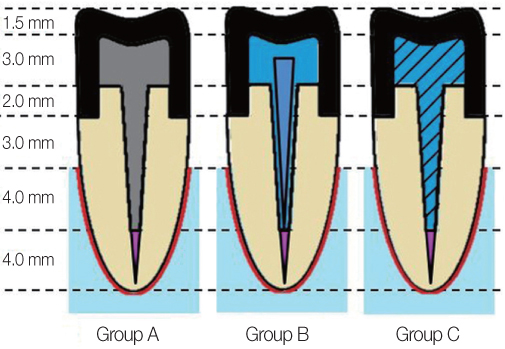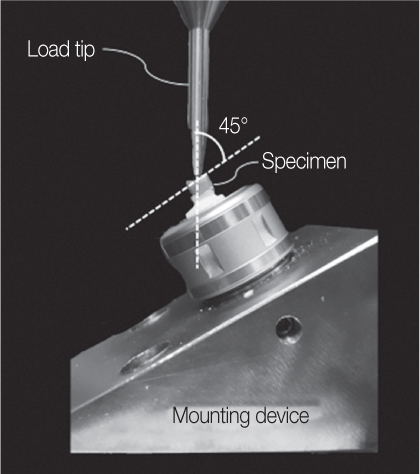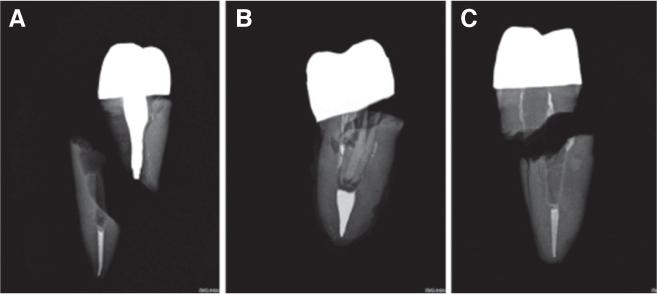J Korean Acad Prosthodont.
2019 Apr;57(2):127-133. 10.4047/jkap.2019.57.2.127.
Evaluation of static fracture resistances and patterns of pulpless tooth restored with poly-ether-ketone-ketone (PEKK) post
- Affiliations
-
- 1Department of Prosthodontics, Seoul St. Mary's Dental Hospital, College of Medicine, The Catholic University of Korea, Seoul, Republic of Korea. lsuyoung@daum.net
- KMID: 2444181
- DOI: http://doi.org/10.4047/jkap.2019.57.2.127
Abstract
- PURPOSE
The purpose of present study was to investigate fracture strength and mode of failure of endodontically treated teeth restored with metal cast post-core system, prefabricated fiber post system, and newly introduced polyetherketoneketone (PEKK) post-core system.
MATERIALS AND METHODS
A total of 21 mandibular premolar were randomly grouped into 3 groups of 7 each according to the post material. Group A was for metal cast post core; Group B for prefabricated glass fiber post and resin core; and Group C for milled PEKK post cores. All specimens were restored with metal crown. The fracture strength of each specimen was measured by applying a static load of 135-degree to the tooth at 2 mm/min crosshead speed using a universal testing machine. After the fracture strength measurement, the mode of failure was observed. The results were analyzed using Kruscal-Wallis test and post hoc Mann-Whitney U test at confidence interval α = .05.
RESULTS
Fracture resistance of PEKK post core was lower than those of cast metal post and fiber reinforced post with composite resin core. In the aspect of fracture mode most of the root fracture occurred in the metal post core, whereas the post detachment occurred mainly in the fiber reinforced post. In the case of PEKK post core, teeth and post were fractured together.
CONCLUSION
It is necessary to select appropriate materials of post for extensively damaged teeth restoration and clinical application of the PEKK post seems to require more research on improvement of strength.
MeSH Terms
Figure
Reference
-
1. Stockton LW. Factors affecting retention of post systems: a literature review. J Prosthet Dent. 1999; 81:380–385.
Article2. Qualtrough AJ, Mannocci F. Tooth-colored post systems: a review. Oper Dent. 2003; 28:86–91.3. Ferrari M, Vichi A, García-Godoy F. Clinical evaluation of fiber-reinforced epoxy resin posts and cast post and cores. Am J Dent. 2000; 13:15B–18B.4. Ferrari M, Vichi A, Mannocci F, Mason PN. Retrospective study of the clinical performance of fiber posts. Am J Dent. 2000; 13:9B–13B.5. Hayashi M, Takahashi Y, Imazato S, Ebisu S. Fracture resistance of pulpless teeth restored with post-cores and crowns. Dent Mater. 2006; 22:477–485.
Article6. Hu YH, Pang LC, Hsu CC, Lau YH. Fracture resistance of endodontically treated anterior teeth restored with four postand-core systems. Quintessence Int. 2003; 34:349–353.7. Komada W, Miura H, Okada D, Yoshida K. Study on the fracture strength of root reconstructed with post and core: alveolar bone resorbed case. Dent Mater J. 2006; 25:177–182.
Article8. Okada D, Miura H, Suzuki C, Komada W, Shin C, Yamamoto M, Masuoka D. Stress distribution in roots restored with different types of post systems with composite resin. Dent Mater J. 2008; 27:605–611.
Article9. Fuhrmann G, Steiner M, Freitag-Wolf S, Kern M. Resin bonding to three types of polyaryletherketones (PAEKs)-durability and influence of surface conditioning. Dent Mater. 2014; 30:357–363.
Article10. Stawarczyk B, Jordan P, Schmidlin PR, Roos M, Eichberger M, Gernet W, Keul C. PEEK surface treatment effects on tensile bond strength to veneering resins. J Prosthet Dent. 2014; 112:1278–1288.
Article11. Hayashi M, Sugeta A, Takahashi Y, Imazato S, Ebisu S. Static and fatigue fracture resistances of pulpless teeth restored with post-cores. Dent Mater. 2008; 24:1178–1186.
Article12. Ko CC, Chu CS, Chung KH, Lee MC. Effects of posts on dentin stress distribution in pulpless teeth. J Prosthet Dent. 1992; 68:421–427.
Article13. Kern M, Douglas WH, Fechtig T, Strub JR, DeLong R. Fracture strength of all-porcelain, resin-bonded bridges after testing in an artificial oral environment. J Dent. 1993; 21:117–121.
Article14. Schwartz RS, Robbins JW. Post placement and restoration of endodontically treated teeth: a literature review. J Endod. 2004; 30:289–301.
Article15. Lee KS, Shin JH, Kim JE, Kim JH, Lee WC, Shin SW, Lee JY. Biomechanical evaluation of a tooth restored with high performance polymer PEKK post-core system: A 3D finite element analysis. Biomed Res Int. 2017; 2017:1373127.
Article
- Full Text Links
- Actions
-
Cited
- CITED
-
- Close
- Share
- Similar articles
-
- Performance Evaluation of the Autokit Total Ketone Bodies
- Implant-retained overdenture with CM LOC ® Pekkton® in maxillary edentulous patient
- A comparison of the fracture resistances of endodontically treated mandibular premolars restored with endocrowns and glass fiber post-core retained conventional crowns
- SGLT2 Inhibitors and Ketone Metabolism in Heart Failure
- The Changes of Arterial Ketone Body Ratio and Osmolal Gap during Hemorrhagic Shock in Rabbit




